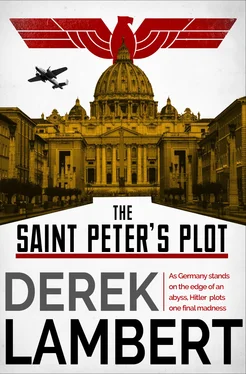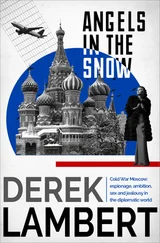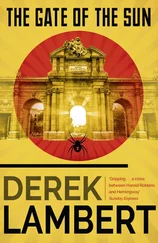THE SAINT PETER’S PLOT
Derek Lambert

COPYRIGHT
This novel is entirely a work of fiction. The names, characters and incidents portrayed in it are the work of the author’s imagination. Any resemblance to actual persons, living or dead, events or localities is entirely coincidental.
Collins Crime Club
An imprint of HarperCollins Publishers Ltd.
1 London Bridge Street
London SE1 9GF
www.harpercollins.co.uk
First published in Great Britain by Arlington Books (Publishers) Ltd 1978
Copyright © Derek Lambert 1978
Design and illustration by Micaela Alcaino © HarperCollinsPublishers Ltd 2018
Cover photographs © Shutterstock.com
Derek Lambert asserts the moral right to be identified as the author of this work
All rights reserved under International and Pan-American Copyright Conventions. By payment of the required fees, you have been granted the non-exclusive, non-transferable right to access and read the text of this ebook on screen. No part of this text may be reproduced, transmitted, down-loaded, decompiled, reverse engineered, or stored in or introduced into any information storage and retrieval system, in any form or by any means, whether electronic or mechanical, now known or hereinafter invented, without the express written permission of HarperCollins ebooks
A catalogue record for this book is available from the British Library
HarperCollins Publishers has made every reasonable effort to ensure that any picture content and written content in this ebook has been included or removed in accordance with the contractual and technological constraints in operation at the time of publication
Source ISBN: 9780008268374
Ebook Edition © MARCH 2018 ISBN: 9780008268374
Version: 2018-03-14
DEDICATION
For Mike and Sybil Keats,
Natasha, my god-daughter, and Alexia.
CONTENTS
Cover
Title Page
Copyright
Dedication
Part I
Chapter I
Chapter II
Chapter III
Chapter IV
Chapter V
Chapter VI
Chapter VII
Chapter VIII
Chapter IX
Chapter X
Chapter XI
Chapter XII
Chapter XIII
Chapter XIV
Chapter XV
Chapter XVI
Chapter XVII
Chapter XVIII
Chapter XIX
Part II
Chapter XX
Chapter XXI
Chapter XXII
Chapter XXIII
Chapter XXIV
Chapter XXV
Chapter XXVI
Chapter XXVII
Chapter XXVIII
Chapter XXIX
Chapter XXX
Chapter XXXI
Epilogue
Keep Reading
About The Author
By The Same Author
About the Publisher
PART I
I
The Commanding Officer of Adolf Hitler’s crack SS regiment took his leave of the Pope at 11.33 am on July 29th, 1943, unaware that he was closer to death than at any time during the bloody campaigns he had fought in Europe and Russia.
By 11.40 am Josef ‘Sepp’ Dietrich was walking briskly — a marching step almost — across St. Peter’s Square towards the line of white travertine stones that links the embracing arms of Bernini’s colonnade and marks the boundary of Vatican territory inside the city of Rome.
Behind Dietrich, former butcher and Munich bully-boy, a young man with the face of a saint and a 9 mm Walther pistol concealed beneath his jacket signalled to an older man stationed on the boundary line.
The older man, his bald patch as neat as a skull-cap, signalled back with the current edition of L’Osservatore Romano, The Vatican newspaper.
As Dietrich passed the Egyptian obelisk a sudden gust of wind disturbed the sultry day blowing plumes of spray from the two fountains, dislodging a prelate’s hat and startling a flock of pigeons into flight.
Dietrich, pugnaciously built, big-eared and cold-eyed, noticed none of this: he was too preoccupied with the speed of recent events. The Allied Invasion of Sicily; the withdrawal of his own regiment, Die Leibstandarte Adolf Hitler, from the Russian front to Italy; the dismissal and arrest on July 25 of Benito Mussolini by his own people.
The next event, Dietrich brooded, would be the capitulation of Italy to the Allies. So? Germany would be better off without them!
By the time Dietrich reached the black Mercedes-Benz waiting for him near the boundary line, the man with the bald patch had climbed into the driving seat of a Fiat 500 fuelled earlier that morning with Black Market petrol.
Dietrich paused beside the Mercedes, drumming his fingers on the bonnet. Beside him stood a plain-clothes driver, rigidly to attention waiting to dive for the door-handle.
But perhaps a walk. It had been a long time since Dietrich, founder in the early ’30s of a unit of shock troops that were the forerunners of the SS, had walked for pleasure. You didn’t walk for pleasure in Russia; you didn’t do anything for pleasure in Russia — except kill Russians.
He turned to the driver. “I’m going to walk back.” The driver displayed no surprise. “Follow me at a discreet distance.”
Dietrich set off towards the Tiber, sweating inside the double-breasted grey suit that he had last worn at a meeting with Hitler at the Eagle’s Nest in the Bavarian mountains.
The suit hung loosely on him. Small wonder after the deprivations of Russia; the battle for Rostov — the Leibstandarte’s first defeat — the Arctic winter of ’42-’43, the Pyrrhic victory at Kharkov.
But in any case, Dietrich felt uneasy in civilian clothes. He was born for uniforms, swaggering uniforms with a silver death’s head badge on the cap, the double runic ‘S’ on a steel helmet, leather belts with My Honour is my Loyalty inscribed on the buckle.
But in Rome the Germans wore civilian clothes. They were not an occupying army. Not yet.
Dietrich observed with contempt the Italians walking the streets of their capital. In particular the men. They couldn’t wait to get out of uniform, and despite the shortages of war they still managed to groom themselves as beautifully as Berlin fairies.
When Dietrich reached the great rounded bulk of Castel Sant’ Angelo, once the military bastion of Rome, he toyed with the idea of recommending that all Italian deserters be thrown into its mediaeval dungeons. And the Jews, of course. As he crossed the Ponte S. Angelo, spanning the khaki-coloured waters of the Tiber, he smiled for the first time that morning.
Behind him, a hundred yards between them, two cars followed — the black Mercedes and the little Fiat. The man with the bald patch had now been joined in the passenger seat by the young man with the Walther. They were arguing.
* * *
The plan had been simple but conceived in haste.
Word had reached the partisans from The Vatican — next to Switzerland the biggest nest of spies in Europe — that Hitler’s most feared and fearless soldier, Sepp Dietrich, had been granted an audience with the Pope.
The core of the partisani was comprised of Italian officers and troops who had seen their fellow countrymen executed by the SS on the Russian front for lack of enthusiasm for what was, to them, an insane and suicidal campaign. Dietrich, the embodiment of SS fanaticism, was an irresistible target in Rome.
But the partisani, busy deploying themselves for the inevitable German occupation, were not yet organised. Dietrich might only stay in Rome for a few hours: the assassination plot had been devised in less than thirty minutes.
According to The Vatican source, Dietrich would, after his audience with the Pope, visit the Most Rev. Alois Hudal, the German bishop renowned for his Nazi sympathies, at his church, S. Maria dell’ Anima.
Читать дальше













